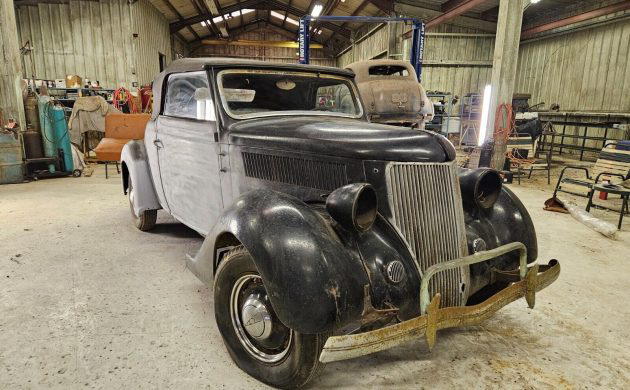
In many ads, sellers will claim that their car is 1 of some number of survivors of that particular make and model. While those numbers are probably in the ballpark, it never ceases to amaze us just how many cars are out there that haven’t seen the light of day for decades, and their whereabouts have been unknown to even experts. Take for example this 1936 Ford cabriolet for sale on eBay in Phenix City, Alabama. While the generally agreed-upon production number for this body style is 14,068 out of 930,778 Fords built, cabriolets are relatively scarce at car shows and in Early Ford V-8 Club meets. Does that mean there are few survivors, or that there are many more out there waiting to hit the market like this restorable, but challenging drop top? With two days to go and 45 bids placed, do you think this vintage Ford will sell for much more than the current bid of $13,700?
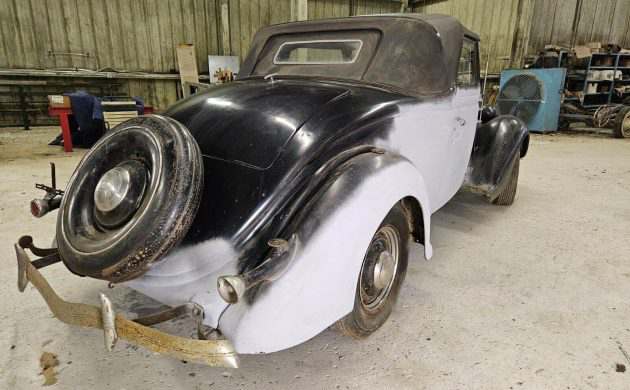
For prewar Ford V-8s, the most desirable years have always been 1932, 1934, 1936, and 1940. While other years looked similar, and all of them were very alike mechanically, those are the years that collectors have traditionally pursued with the most vigor. Once you select a year, a body style choice is next. Three-window coupes have always been highly coveted by hot rod enthusiasts, and everyone likes open cars. If you were looking for an open Ford in 1936, your choices were between a roadster, a cabriolet a club cabriolet (4-seater), a phaeton, and a convertible sedan. Roadsters and phaetons are stunningly beautiful and not very practical due to the use of side curtains. Convertible sedans are easier to live with, but the styling comes across as a bit dowdy. A cabriolet or a much rarer club cabriolet would be a great compromise between convertible fun and everyday practicality with a bit of style.
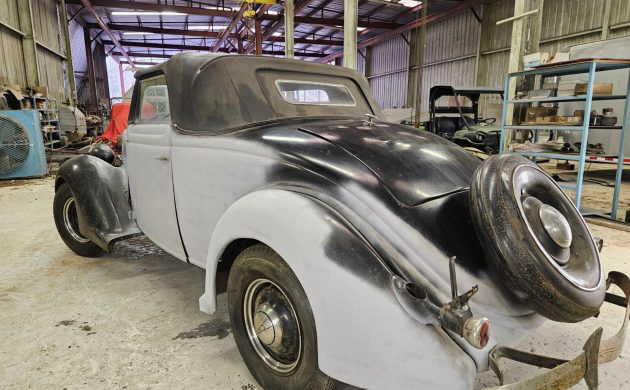
So, between their good looks and general practicality, cabriolets are heavily sought after. Even more so if they are equipped with a Columbia two-speed rear end, which was a unit that acted as an overdrive. Being highly coveted, these cars were first in line for restoration if they survived daily use, World War II, being a used car, the hot rod movement, rust, and teenagers. We still see a number of these older restorations pop up and change hands. However, unrestored examples in this day and age are either cars that were deemed unrestorable back then or are as rare as the hen’s proverbial teeth or ethical politicians.

Therefore, it is amazing to see this car pop up on eBay. According to the seller, it was purchased around 20 years ago as a package deal with a 1936 Ford five-window coupe. The previous owner embarked on a mission to strip the paint on both cars down to the metal. While his intentions were surely to repaint the cars, this never got done. It appears that he never even finished stripping this car. All of the years that these cars have sat in a mismatch of paint and primer applied to the bare metal. The seller had intentions of getting both cars back on the road. As we all well know, life gets in the way.
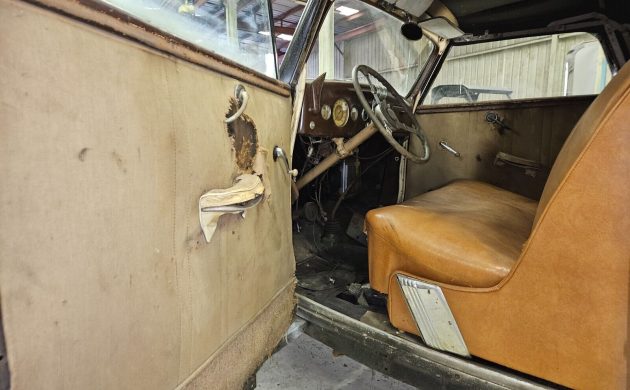
As it sits, the car still has its original floors and mechanical brakes. It also runs. Well, kind of. The seller and his father set out to see if the car could be made to run ten years ago. They filled the cylinders with WD-40 and Marvel Mystery oil and let the solvents do their magic. They then towed the car while leaving it in gear or maybe putting it in gear and engaging the clutch. After some time dishing out this abuse, the engine was free enough to spin with just the starter providing the rotation. They added a fuel pump, coil, plugs, plug wires, and a carburetor, filled the radiator, and hit the starter. After a few attempts, the engine cranked on its own, belched out some smoke from the solvents, and settled into an idle. The car was then put in gear, moving forward in first gear, and, no surprise, moved backward in reverse. Only water flooding from the radiator and radiator hoses put a halt to the festivities.
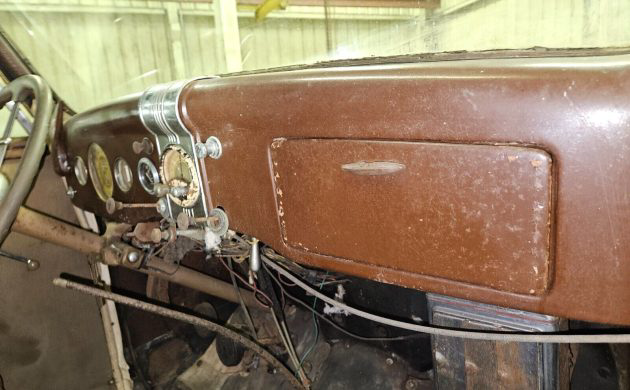
Once you get past these misadventures and look at the car, it is rough in some areas but quite promising if you look deeper. The body is in very good shape despite having spent a lot of time with the paint stripped off of it. Inside, we see that the car was equipped with a heater and a radio. The radio controls were placed in the dash where the ashtray was normally mounted. The actual unit that provided the sound and held all the tubes and such bolted to the firewall above the steering column. This unit is a heavy and bulky beast, and none of the pictures give a clear enough view of its location to confirm or deny its existence in the car.
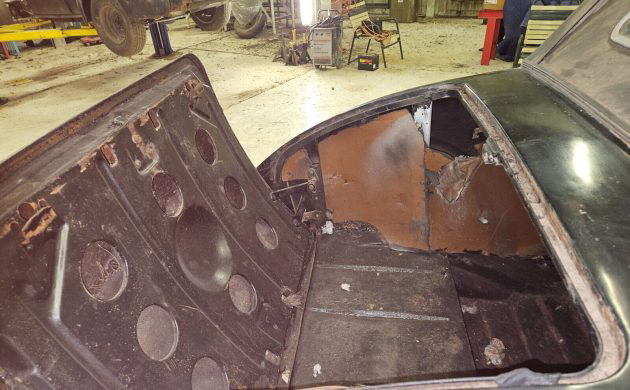
In the rumble seat area, we can see part of the floor. It is good to see that the claims of an undamaged floor are true. Convertibles live hard lives as they pass from one owner to another as they descend in value. Once the canvas starts to rot or the new owner is careless with protecting his cheap ride from the weather, the floors take a lot of liquid abuse. As for the rumble seat, pictures in the ad show what we believe to be the seat frame and springs for it.

Under the hood, we see a later Flathead engine. 1936 Fords still wore the water pumps in the front of their heads and were not the most efficient iteration of the Flathead when it came to cooling. This was also the year that Ford abandoned Babbit bearings in cars and went to much more practical insert bearings for the crankshaft. Many accounts have Ford producing both engines simultaneously and dropping them into cars on the production line for a time. For this car, the engine may be incorrect but is more than suitable for a driver after a cleanup and inspection. Also interesting is the bank of unconnected fuses on the firewall. 1936 cars had but two fuses under the dash, so the presence of these presents a bit of a mystery.
As a whole, the car is a very complete example that would need to be restored. It is simply too rough to slap some tires on it and get it back on the road. As times have changed, that restoration will likely exceed the car’s value on paper. However, the true value of this car is as a really good driver. If it were mine, I would restore the car, but put in a mildly hot-rodded Flathead and install a five-speed conversion kit to put a later model transmission in it. A Columbia two-speed would be a proper choice, but there are a lot of positive reports of these conversions making these cars much better drivers. This is a rare chance to start from scratch on a cabriolet and build it the way you want it.






The rarest model (at least in production numbers) is the Roadster, with 3,862 units built.
Horrendous abuse of the engine and drivetrain.
But money can fix anything.
I would leave the flat head but…
Some hot rod alum aftermarket heads, triple carbs , better rear end gears and trans … then of bore it out and headers
The 35-36 was such a beautiful work of art body by Ford…
My brother’s driver is a baby blue 36 Ford Cabriolet. Chevy powered, Front suspension has been changed and disc brakes. Custom interior.
My Grandpa bought a new 1936 Ford, 4 Door Sedan of some kind, (in 1936). Earlier, he bought a 1929 Model A for $75, but had his sights on a new Ford, someday. He set up a plan to make car payments, of sorts, to a savings account, and I guess, by 1936 he had enough saved to buy a 1936 Model.with Cash. In fact, my Grandfather never financed a car. He was said to have always paid Cash, for his cars.
Leave well enough alone and allow future generations the true experience of driving a genuine ’30s Ford V8 and the genius behind it.
Hello, I am the current owner of this car. Thank you for your kind narrative. The brakes however have been changed to the later model 39 Ford hydraulic. Considering how easy it is to steer just moving it around the shop, I believe it also has the superior 39 steering gear. I also have 2 1936 Ford roadsters. One of them is an AACA national first place winner. When I purchased this car, it had the 36 steering gear and believe me I know the difference. Since this cabriolet had a later model 24 stud flatty, I would assume the tranny was updated to the 39 which has the synchronizer, but without shifting the moving car into 1st, 2nd and 3rd I cannot be sure of that, and I cannot visually tell the difference. You have sparked my interest with the overdrive comment. I will be getting under the car to look at the rearend to see if it has the 2 speed Columbia. I love these 36 Fords, currently I have several restored models: 1936 Fordor, 1936 Cabriolet-hotrod, 1936 5 window and 2 1936 Roadsters. To say the least, I know the 1936 FORD’s. Good luck to my fellow car enthusiast. There’s nothing as rewarding as finding that pristine barn finds.